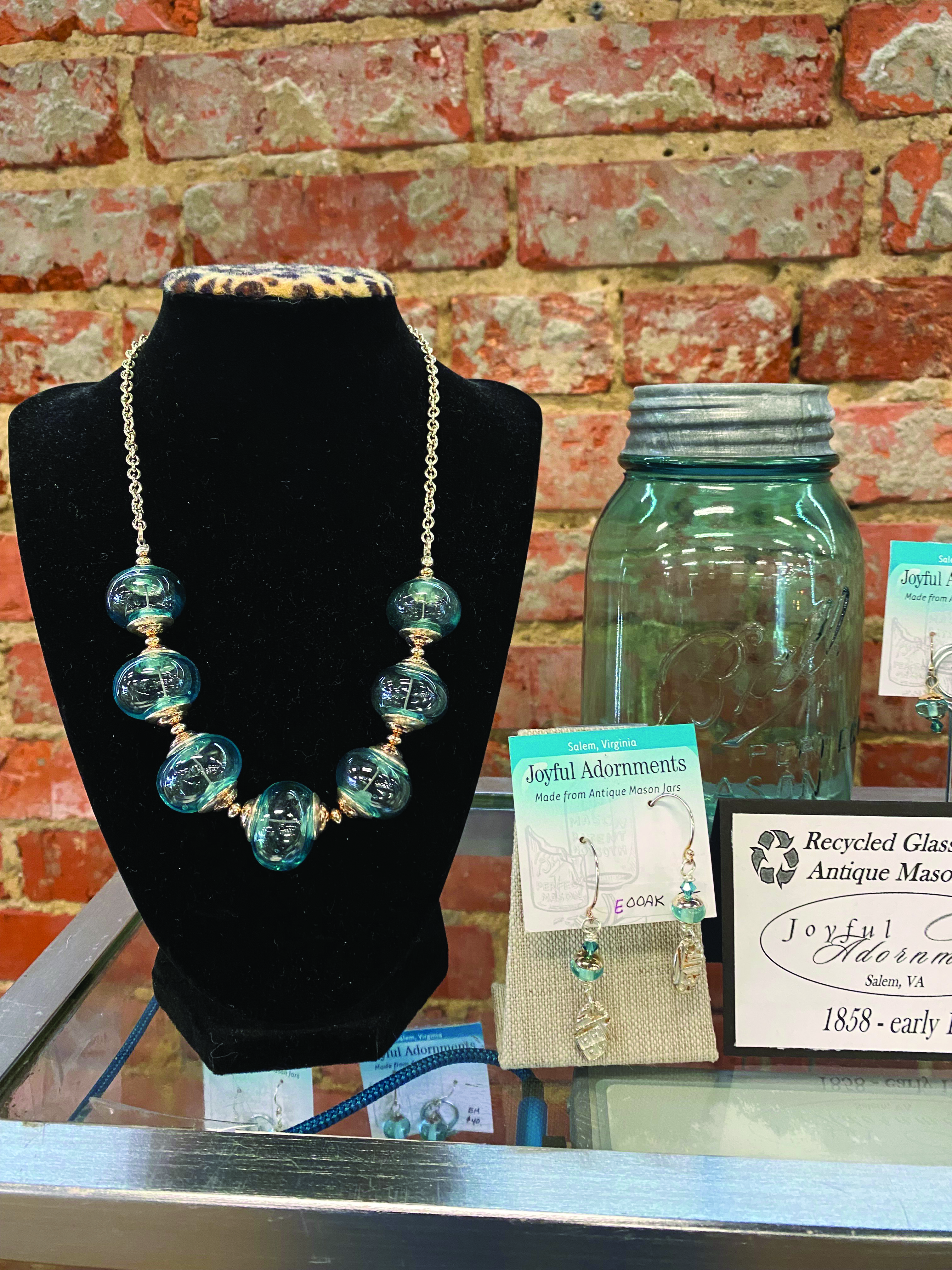

Bonny Scott's jewelry is created from recycled Mason jars.
Bonny Scott of Salem, Virginia, sells her unusual and beautiful glass work at Holston Mountain Artisans, Abingdon, Virginia.
“I love the atmosphere at HMA. The staff is friendly and helpful, and there is a good variety of quality arts and craft in a great location in Abingdon. I’ve enjoyed working with them for almost seven years now. Their new location is a real turning point in how well they have been providing the artisans in the region with a spectacularvenue where tourists and locals alike come to findquality and unique handcrafted items,” she says.
Scott creates glass jewelry, and kitchen and wine accessories from antique canning jars.
“People have strong feelings about the antique canning jars and whatever the conversation, they have a story to tell. This line of glass work helps recycle a piece of history by renewing the bond with the story and creates an heirloom quality keepsake to use and enjoy. There is no greater reward for my work than personal connection.
“Over the years I have explored many traditional flame-working techniques. I created original design thread spool beads and unique glass buttons because of my modern quilting hobby. I then discovered a passion for using recycled glass. It started because I lived in the Finger Lakes Region of New York in the hills surrounding Seneca lake, where wineries are plentiful. I began by making custom jewelry pieces for brides from their recycled event bottles. I then made wine bottle jewelry for the wineries. This has grown to include my current exploration of recycled antique blue and green Ball canning jars. The memories that touch people when they wear a piece of jewelry from meaningful recycled glass fills my heart with joy,” she says.
She has studied flamework with Jen Zitkov, Trey Cornet, Leah Fairbanks, Caitlin Hyde, Kristina Logan, Loren Stump and Heather Trimlett.She studied cold working and engraving glass with Pavel Noval, Martin Rosol, Max Erlacher, Master Steuben Glass Engraging Craftsman and Heather Hartle. She is also certified in using Precious Metal Clay and occasionally combines that medium in her designs. She studied PMC with Martha Bigger, Celie Fago, Sherry Fotopoulos and Marta Edocs.
Her original design beadshave gained in popularity and have been published in “Quilter’s Home,” “Quiltmaker,” “Quilting & Embroidery” and the American Sewing Guild’s Private Newsletter, “Notions.”
In 2005, after her father died, she brought home a green glass bottle that originally contained prune juice. It was 9”x3.5.” It was used as a water bottle in their refrigerator when she was growing up, and her father used it until his death.
“I set it on the table of my glass studio, which was in a carriage house with no heat. I was making glass only when I could stand the ambient temperatures. Somehow it got broken, and I was sad that the physical reminder of a memory was gone. Or was it? I make things with glass and fire, why couldn’t I do something with this? So I ended up experimenting with the glass and thinking through the rules of glassmaking to be sure that I would come out with a stable item. I created several beads that were given to my daughter and relatives. It was a lovely way to share the memory,” Bonny says.
Scott was making things out of wine bottles for a friend’s winery, when another friend asked if she could make something out of an antique Mason jar that belonged to her friend’s mother.
“People who saw the Mason Jar beads were fascinated with the color, and the memories it evoked. Thus a new line of beads was begun. I continue to develop the process of making interesting beads from a singular color. Keeping the glass stable from breaking when cooling is the challenge. So I am always experimenting with how to make a bead interesting with shape, design and texture from the same jar batch. Adding other glass elements could create instability,” she says.
As she continues to experiment with the jar materials, there are rules she has to consider. The recipe for each jar when manufactured was a little different because of the quantity of iron and other materials in the glass. You can see the difference in the color of the jar. Older glass is a paler green and then there is the color called “Ball Blue” or aqua.
The basic elements in the formula for glass are sand, soda and lime. The natural color for the jars made by the Ball Brothers in Muncie, Indiana, was aqua because of the iron in the sand. Different companies used different stockpiles of sand. In 1937, the stockpile of sand the Ball Company was using was depleted and that was the last of jars that color.
In addition to Holston Mountain Artisans, Scott’s work can be purchased at Landy’s Pharmacy Gift Shop, Columbia, South Carolina; Hamilton Williams Gallery and Studio, Morganton, North Carolina; Black Dog Salvage Market, Roanoke, Virginia; Folk Art Center of the Southern Highlands Craft Guild, Asheville, North Carolina; Parkway Craft Center of the Southern Highlands Craft Guild, Blowing Rock, North Carolina; and Mountain Nest Gallery, Black Mountain, North Carolina.